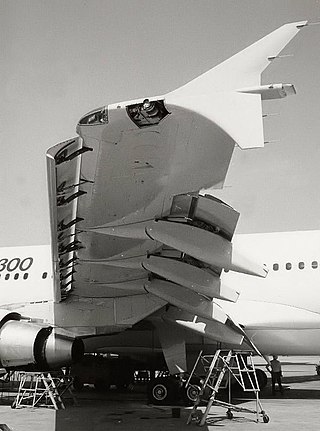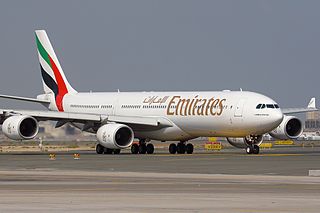Related Research Articles

Landing is the last part of a flight, where a flying animal, aircraft, or spacecraft returns to the ground. When the flying object returns to water, the process is called alighting, although it is commonly called "landing", "touchdown"a or "splashdown" as well. A normal aircraft flight would include several parts of flight including taxi, takeoff, climb, cruise, descent and landing.
In fluid dynamics, angle of attack is the angle between a reference line on a body and the vector representing the relative motion between the body and the fluid through which it is moving. Angle of attack is the angle between the body's reference line and the oncoming flow. This article focuses on the most common application, the angle of attack of a wing or airfoil moving through air.

The Lockheed Martin X-33 was a proposed uncrewed, sub-scale technology demonstrator suborbital spaceplane that was developed for a period in the 1990s. The X-33 was a technology demonstrator for the VentureStar orbital spaceplane, which was planned to be a next-generation, commercially operated reusable launch vehicle. The X-33 would flight-test a range of technologies that NASA believed it needed for single-stage-to-orbit reusable launch vehicles, such as metallic thermal protection systems, composite cryogenic fuel tanks for liquid hydrogen, the aerospike engine, autonomous (uncrewed) flight control, rapid flight turn-around times through streamlined operations, and its lifting body aerodynamics.

The Douglas X-3 Stiletto is a 1950s United States experimental jet aircraft with a slender fuselage and a long tapered nose, manufactured by the Douglas Aircraft Company. Its primary mission was to investigate the design features of an aircraft suitable for sustained supersonic speeds, which included the first use of titanium in major airframe components. Douglas designed the X-3 with the goal of a maximum speed of approximately 2,000 mph (3,200 km/h), but it was seriously underpowered for this purpose and could not even exceed Mach 1 in level flight. Although the research aircraft was a disappointment, Lockheed designers used data from the X-3 tests for the Lockheed F-104 Starfighter which used a similar trapezoidal wing design in a successful Mach 2 fighter.

Aviation safety is the study and practice of managing risks in aviation. This includes preventing aviation accidents and incidents through research, educating air travel personnel, passengers and the general public, as well as the design of aircraft and aviation infrastructure. The aviation industry is subject to significant regulation and oversight.

Flight 90 of the North American X-15 was a research flight conducted by NASA and the US Air Force on July 19, 1963. It was the first of two X-15 missions that passed the 100-km high Kármán line, the FAI definition of space, along with Flight 91 the next month. The X-15 was flown by Joseph A. Walker, who flew both X-15 spaceflights over the Kármán line.

A flap is a high-lift device used to reduce the stalling speed of an aircraft wing at a given weight. Flaps are usually mounted on the wing trailing edges of a fixed-wing aircraft. Flaps are used to reduce the take-off distance and the landing distance. Flaps also cause an increase in drag so they are retracted when not needed.

The Bell X-14 is an experimental VTOL aircraft flown in the United States in the 1950s. The main objective of the project was to demonstrate vectored thrust horizontal and vertical takeoff, hover, transition to forward flight, and vertical landing.

The Controlled Impact Demonstration was a joint project between NASA and the Federal Aviation Administration (FAA) that intentionally crashed a remotely controlled Boeing 720 aircraft to acquire data and test new technologies to aid passenger and crew survival. The crash required more than four years of preparation by NASA Ames Research Center, Langley Research Center, Dryden Flight Research Center, the FAA, and General Electric. After numerous test runs, the plane was crashed on December 1, 1984. The test went generally according to plan, and produced a large fireball that required more than an hour to extinguish.
Flight testing is a branch of aeronautical engineering that develops specialist equipment required for testing behaviour and systems of aircraft or testing the atmospheric phase of launch vehicles and reusable spacecraft. Instrumentation systems are developed using proprietary transducers and data acquisition systems. Data is sampled during the flight of an aircraft, or atmospheric testing of launch vehicles and reusable spacecraft. This data is validated for accuracy and analyzed to further modify the vehicle design during development, or to validate the design of the vehicle.
In aviation, a balanced field takeoff is a condition where the takeoff distance required (TODR) with one engine inoperative and the accelerate-stop distance are equal for the aircraft weight, engine thrust, aircraft configuration and runway condition. For a given aircraft weight, engine thrust, aircraft configuration, and runway condition, the shortest runway length that complies with safety regulations is the balanced field length.

A personal air vehicle (PAV) is a proposed class of passenger aircraft providing on-demand air transport.
W. K. Kellogg Airport is a city-owned, public-use, joint civil-military airport located three nautical miles (6 km) west of the central business district of Battle Creek, a city in Calhoun County, Michigan, United States. The airport is accessible by road from Helmer Road, and is located near I-94. It is included in the Federal Aviation Administration (FAA) National Plan of Integrated Airport Systems for 2017–2021, in which it is categorized as a regional general aviation facility. It is also known as W. K. Kellogg Regional Airport.
BMT Group Ltd, established in 1985, is an international multidisciplinary engineering, science and technology consultancy offering services particularly in the defence, security, critical infrastructure, commercial shipping, and environment sectors. The company's heritage dates to World War II. BMT's head office is at the Zig Zag Building, 70 Victoria Street Westminster, London, United Kingdom.

The High Speed Civil Transport (HSCT) was the focus of the NASA High-Speed Research (HSR) program, which intended to develop the technology needed to design and build a supersonic transport that would be environmentally acceptable and economically feasible. The aircraft was to be a future supersonic passenger aircraft, baselined to cruise at Mach 2.4, or more than twice the speed of sound. The project started in 1990 and ended in 1999.

In aviation, V-speeds are standard terms used to define airspeeds important or useful to the operation of all aircraft. These speeds are derived from data obtained by aircraft designers and manufacturers during flight testing for aircraft type-certification. Using them is considered a best practice to maximize aviation safety, aircraft performance, or both.

Continental Airlines Flight 1404 was a Continental Airlines domestic flight from Denver International Airport in Denver, Colorado, to George Bush Intercontinental Airport in Houston, Texas. On the evening of December 20, 2008, the flight crashed while taking off from Denver, resulting in two critical injuries, 36 noncritical injuries, and a hull loss of the Boeing 737-524 aircraft.

Emirates Flight 407 was a scheduled international passenger flight operated by Emirates from Auckland to Dubai with a stopover in Melbourne, operated by an Airbus A340-500 aircraft. On 20 March 2009, the flight failed to take off properly at Melbourne Airport, hitting several structures at the end of the runway before climbing and then returning to the airport for a safe landing. Although no fatalities or injuries resulted, damage to the aircraft was severe enough for the event to be classified by Australian Transport Safety Bureau as an "accident". It was subsequently determined that a data-entry error resulted in insufficient engine thrust during take off. It has been described "as close as we have ever come to a major aviation catastrophe in Australia" by aviation officials.
Aircraft have different ways to take off and land. Conventional airplanes accelerate along the ground until reaching a speed that is sufficient for the airplane to takeoff and climb at a safe speed. Some airplanes can take off at low speed, this being a short takeoff. Some aircraft such as helicopters and Harrier jump jets can take off and land vertically. Rockets also usually take off vertically, but some designs can land horizontally.

On 21 July 2017, a Boeing 737-800 belonging to and operated by Sunwing Airlines Inc. and operating as Thomson Airways Flight 1526 from Belfast International Airport and bound for Corfu, Greece with 185 people aboard, suffered a "serious incident" during takeoff, colliding with a runway approach light during departure. The incident was investigated by the Air Accidents Investigation Branch and determined to be the result of an incorrect temperature input into the aircraft's flight computer resulting in underperformance at take-off. The area beyond the runway and the terrain beyond were largely unobstructed, and the aircraft eventually climbed away undamaged. The remainder of the flight to Corfu was uneventful. The "serious incident" at take-off was realized and reported when airport staff subsequently observed minor ground damage. The investigation report concluded that the crew could not reasonably have been expected to recognize the anomalously low speed sooner or intervene more effectively. The report listed several examples of aircraft underperformance at takeoff, reviewed the history of relevant industry efforts, and recommended that a Takeoff Acceleration Monitoring System and associated certification standards should be developed without further delay.
References
- ↑ Brown; Abbasi (2009-04-23). "Takeoff performance monitoring systems, technology, certificatability and operability status". National Research Council Canada. doi: 10.4224/21268868 .
- 1 2 3 Benard, Bart (2019). "Take-Off performance incidents: do we need to accept them or can we avoid them?" (PDF). ISASI Technical Papers.
- ↑ Hoare, Steve (2019). "Erroneous takeoff performance: Why the past is still highly relevant today" (PDF). ISASI Technical Papers.
- ↑ Middleton (March 12, 1996). Airplane takeoff and landing performance monitoring system. NASA (Report). hdl:2060/20080005969.